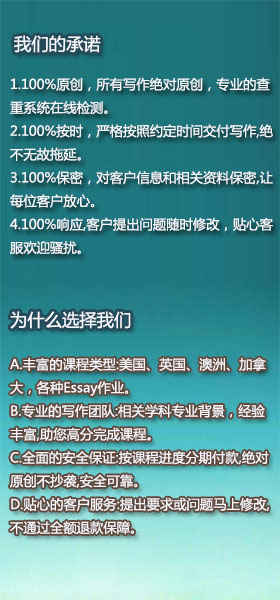铭信提供:加拿大assignment代写、exam代考、assignment代写、exam代考、加拿大代写、新加坡assignment代写、exam代考、商业学assignment代写、exam代考、北美assignment代写、exam代考、北美学期作业代写、北美留学生代写、澳洲代写、网课代修、exam代考、、exam代考代上、quiz代考、exam代考、网课托管、online exam代考、online exam代考、学期陈述代写、留学生代写、online exam/quiz代考、网课代考、essay代写、代考、exam代考、paper代写...

顾客对途径运用能力的决心非常重要。跟着信息技术的开展,以计算机为根底的服务途径越来越遭到广大客户的喜爱,尤其是年轻人。当客户尝试运用一个新的途径时,在运用领会之前的客户途径将起到很大的作用,特别是当两个途径根据相同的技术根底,并且是根据网上银行的网络时。假设客户熟练或有互联网阅历,客户早年运用网络技术或其他电子途径的阅历将增加运用网上银行的可能性。也便是说,客户运用网上银行的意愿受其早年运用相关技术阅历的影响。在满意客户不同需求的根底上,根据客户需求的改动,对相应的途径进行改造或升级(Fichter,&Wisniewski,2017)。影响客户搬运意愿的要素很多。一些客户垂青途径的易用性,如货台,而另一些客户垂青本钱要素(辅导全途径客户旅程,2015年)。但是客户途径搬运的目的可以通过鼓舞营销来改动,这样当客户了解其他途径时,不只可以前进客户使用某一途径的成效,前进客户满意度,而且可以前进银行的资源使用率。反过来,美国前进了银行的收益。
Consumers' confidence in the ability to use a channel is very important. With the development of information technology, computer based service channels are favored by more customers, especially young people. When customers try to use a new channel, customer channels before using experience will play a big role, especially when the two channels are based on the same technology base, and is based on the network of the bank on the net. If the customer is skilled or experienced in the Internet, the experience of the customer's prior use of network technology or other electronic channels will increase the possibility of using online banking. That is, the willingness of the customer to use an online bank is influenced by his or her prior use of relevant technical experience. On the basis of satisfying customers' different needs, the corresponding channel is transformed or upgraded according to the change of customers' demands (FICHTER, & WISNIEWSKI, 2017). There are many factors influencing the willingness of customers to transfer. Some customers value the ease of use of channels such as the counter, while others value the cost factors (Guiding the Omnichannel Customer Journey, 2015). But customer channel transfer intentions can change, through the incentive marketing, so that when the customers are familiar with other channels, not only can improve the utility of customers to use a certain channels, improve customer satisfaction, and can improve the resource utilization of Banks, in turn, improve the Banks' earnings.
根据客户的特点对其进行分类,使银行可以了解客户的状况,清晰客户的需求,协助银行拟定和调整营销战略。本文根据客户途径价值对客户进行分类,清晰客户途径的所有权,为银行拟定多途径客户办理战略供给根据。根据客户途径价值和服务本钱的两个维度,根据途径可将客户分为四类(Tompkins,2015)。本文将途径分为四类,每个途径有四种客户。不同途径的客户有不同的办理战略,剖析如下。
Classify customers according to their own attributes, so that Banks can understand the status of customers, clarify customer needs, and help Banks to formulate and adjust marketing strategies. This paper classifies the customers according to the customer channel value, clarifies the ownership of the customer channel, and provides the basis for the bank to develop multi-channel customer management strategy. According to the two dimensions of customer channel value and service cost, the customer can be divided into four categories according to the channel (Tompkins, 2015). This article divides the channel into four categories, each channel has four kinds of customers. There are different management strategies for customers with different channels, and the analysis is as follows.
客户:货台关于货台价值高的客户和银行来说,服务本钱高的客户应该坚持货台价值高的客户,这样的客户便是银行的高端客户,为了货台的高附加值业务,这种客户银行应该尽量下降服务本钱。关于货台价值较高、服务本钱较低的客户比例虽然小,但这类客户是银行的客户忠诚度较高的客户,应继续开掘此类客户的潜力,穿插出售,采用一贯的战略。为了应对低值客户服务本钱高,这种客户占有货台服务本钱高,应尽量引导客户运用服务本钱低的途径,假设没有希望增值而只运用货台的客户,可以考虑抛弃这个客户(pophAl,2015年)。
Client: the counter for the counter value in a high cost of services to our clients and Banks should keep the high counter value of the customer, such customer is bank of high-end customers, to counter the high value-added business, this kind of customer Banks should try to reduce the service cost. For the counter value higher service costs low proportion of customers although small, but such is the bank's customer loyalty customers, should continue to develop the potential of such customers, cross-selling, take strategy consistently. To counter low value a customer service cost is high, this kind of customer occupy the counter service cost is higher, should try to guide customers to use service costs lower channel, if there is no hope value-added and only use the counter the customer, can consider to give up this customer (POPHAL, 2015)..
Online banking customers: net silver is one of the emerging electronic service channels, channels and service function only time counter, but due to time is shorter, utilization rate is low, customer for online banking for online banking customer value higher service costs high, although this kind of customer service cost is higher, but should continue to use the marketing strategy, make its maintain at higher satisfaction, increasing the chances of the incremental sales and referrals. For online banking customer service cost is high, low value a net silver can not plan for small but customer classification, the result of the low cost of customer value higher net silver to net, such customer is an ideal way to bank customers, Banks should expand the proportion of such customers. Net silver to a low value net silver low-cost customer, the customer accounts for larger, such customers have begun to use net silver but only simple business, while net silver low value but Banks focus on objects, Banks should strengthen marketing. Make it a high-net-worth customer (DEERING, 2015).
POS customer: POS machine is an important service channel for customers to use electronic money. POS value high service cost high customer, the bank continues to use the corresponding promotion strategy, is the customer maintains a high consumption record. Banks should be most responsive to the use of consumer but less valued customers to implement marketing strategies.
ATM customers, which have a strong correlation with the customer's own diamond level customer, but the customer channel chooses the important channel. And prolong the service time of the Banks of external window, at the same time, the business development is rapid, it can even provide sales tickets, tickets and other business, make, very good to satisfy customers' personalized requirements.
Can draw channels of Banks by adjusting the marketing strategy, can change the channel choice behavior, in turn, increase profits, namely to meet customer needs on the basis of maximizing profits and achieve a win-win goal. Implementing channel promotion strategy can change the channel usage behavior of customers, and the bank should work out different promotion strategies according to the evolution of customer status. Different channel promotion strategies are different for Banks to generate profits. The bank should make reasonable channel promotion strategy to maximize the bank profit. Banks should be consistent in implementing channel promotion strategies, and only continuous channel promotion strategies can enable customers to form channel loyalty.
The solution of the optimal promotion strategy under the win-win target can enable the bank to implement the corresponding channel promotion strategy according to the change of the state of the customer channel (Greengard, 2016).. Changing customer channel by channel strategy choice behavior, under the condition of satisfy the customer demand increase the profit of bank, the bank can be product at the right time, the appropriate channels to a demand for customers, commercial Banks should build a powerful integrated management platform, form the multi-channel management advantages, improve marketing channels added value, and improve the core competitiveness of commercial Banks, finally realizes the win-win between Banks and their customers.
reference list
DEERING, S. (2015). IMPROVE OMNICHANNEL SERVICE. Credit Union Magazine, 81(2), 26-30.
FICHTER, D., & WISNIEWSKI, J. (2017). Tackling the Omnichannel Experience With Customer Journey Mapping. Computers In Libraries, 37(8), 4-7.
Greengard, S. (2016). Why AI Is the Future of Customer Satisfaction. CIO Insight, 1.
Guiding the Omnichannel Customer Journey. (2015). CRM Magazine, 19(10), 23.
POPHAL, L. (2015). Multichannel vs. Omnichannel Marketing: Is There a Difference, and What Does It Mean to You?. Econtent,38(2), 15-20.
Tompkins, J. (2015). Omnichannel logistics make happy customers. Industrial Engineer: IE, 47(10), 24.





